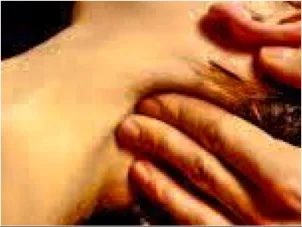Q: What might be done to alleviate neck pain (recently diagnosed with cervical disc degenration)?
A: I see disc degeneration and arthritis as possible symptoms of excessive compression or uneven tension. So the first thing I investigate is where some slack can be found. Conceptually, the spine is simply a stack of blocks with cushions between them. Guy wires - the erector spinae - anchor in at the sacrum and run up on either side of the spine to tie in at the occiput, the base of the skull. Slack may be found anywhere along that stretch.
Tension comes into these 'guy wires' for different reasons. For example, tightening the shoulders while hunching over a laptop can cause muscles there (e.g. rhomboids, trapezius) to grip the vertical stretch of erector spinae reaching past toward the occiput. Whiplash resulting from a rear-end car accident can lead to local stabilization in the upper back and neck through the thickening of fascial tissue - e.g. stabilizing across fragile components such as cervical vertebrae, or by creating adhesions between less stable components and a more robust anchor such as the erector spinae.
One of the most effective treatment I've discovered for reducing spinal compression / tension is to gather tissue from either side of the spine - just lateral to the erector spinae - and to coax it toward the center line. Don't spread it away. The extra tissue creates incremental slack in the erector spinae, hence length, allowing the vertebral discs to expand gapping the vertebrae themselves.
The tension in the fingers has to be enough to provide direction and to meet the tissue's existing tensional quality. So its a bit of pressure - not necessary to be forceful - focused at a depth in which you begin to discover the denser resistance and at an angle which would bring all this tissue you've gathered toward the center line of the spine. To be most effective, guide this tissue toward the discs between the vertebrae and in a slightly superior - northerly - direction.
Start shallow - the tissue seems to be set down in layers - and once the layer you're on begins to move, follow this until it finds a new position. My own experience is that with patience and steady pressure - keep your fingers in the same position - denser material becomes gel-like and flows into specifically the correct position to give the body more space and order.
I describe all this with the image of your giving yourself small mini-treatments. You'll be the best one to refine and direct the movement as you'll have the best internal sense of where the compressions exist. Alternately you could seek out a practitioner of structural integration or rolfing, or request a bodyworker whom you trust to work slowly and carefully along the lines I've described.
To do this sort of work for myself, I'll lay on my back with my elbows bent and the fingers of either hand touching into the sides of the cervical - neck - vertebrae. There's a thick strip of tissue overlaying the cervical from the occiput down to the 7th cervical - the big bulbous one - called the 'nuchal ligament'. Simply easing your fingers into the side of this strap and coaxing it centrally a bit at a time along its entire length can result in a huge difference in neck tension.
A side comment that I ought to add in here is that the tension in the neck can be caused by tension in the jaw and / or eyes. Soften your jaw (and notice if tension creeps back in) while you're doing the exercise above. Conceptually, drop your eyes to the back of your skull and soften your gaze. The muscles giving fine motor control to actions such as swiveling the head are habitually synchronized with eye movements, and insert at the occiput.
Finally, keep your head lifted and centered over the spine - thrusting the chin forward results in shortening (i.e. compression) in the first few cervical vertebrae. There are all sorts of tricks and techniques to correct this alignment - e.g. envisioning a string attached to the top of your head and disappearing into the sky above, drawing you lightly upward - and I'm certain practitioners of Alexander Technique can help out lots.
That's it for my first pass on this. I'm hoping it helps you, or at least gives you some ideas worth pursuing.
